Dip Coater User Manual

Contents
- Overview
- EU Declaration of Conformity (DoC)
- Safety
- Warning
- Use of Equipment
- Hazard Icons
- General Hazards
- Servicing
- Health and Safety - Installation
- Health and Safety - Servicing
- Crash Detection Switch
- Unpacking
- Specifications
- System Components
- Installation
- Operation
- Dip Coater Diagram
- Dip Coater User Interface
- Practical Operation
- Program Operation
- Operational Safety
- Maintenance
- Troubleshooting
Dip Coater

1. Overview
The Ossila Dip Coater is a simple-to-use system designed to deposit thin wet films of solution. Dip coating involves the controlled immersion and withdrawal of a substrate from a reservoir of solution, it is widely used in research and development as well as large-scale production.
Film thickness is determined by a balance between several competing forces on the fluid’s surface: viscous force, capillary forces, and draining forces. Ultimately, film thickness is determined by a combination of the solution properties and the rate of substrate withdrawal from the solution.
The Ossila Dip Coater can finely control properties such as the immersion speed, dwell, time, withdrawal speed, and drying time. This gives you accurate control over the final thickness and properties of the deposited film. Equipped with high-precision motors, the system offers excellent accuracy and reproducibility for travel speeds and substrate positioning. In addition, the system provides a wide range of coating speeds (ranging from 0.01mm.s-1 to 50mm.s-1), variable withdrawal rates for graded films, and the option to perform repeat cycles. Additional software features include user profiles, saveable programmes, crash-sensing software, and changeable working units.
The Ossila Dip Coater’s wide working base means that larger beakers (up to 2 litres in size) can be used. As the movement distance of the arm is 110mm, you can coat substrates over 100mm in length. Its clamping mechanism uses a simple springloaded clamp for easy substrate removal. Clamp pressure can be adjusted to suit either delicate or heavy substrates. To ensure user safety, the Ossila Dip Coater comes with an inbuilt crash-sensing switch. This will stop the motor if the arm hits an object, protecting your substrates and glassware.
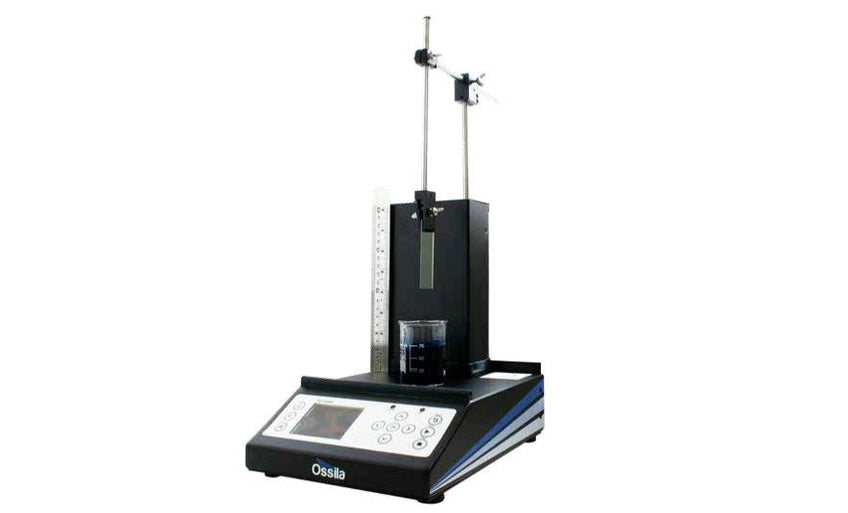
2. EU Declaration of Conformity (DoC)
We
Company Name: Ossila BV
Postal Address: Biopartner 3 Building, Galileiweg 8
Postcode: 2333 BD Leiden
Country: The Netherlands
Telephone Number: +31 (0)718 081020
Email Address: info@ossila.com
declare that the DoC is issued under our sole responsibility and belongs to the following product:
Product: Dip Coater (L2006A1)
Serial Number: L2006A1 - xxxx
Object of Declaration
Dip Coater (L2006A1)
The object of declaration described above is in conformity with the relevant Union harmonization legislation:
Machinery Directive 2006/42/EC
EMC Directive 2014/30/EU
RoHS Directive 2011/65/EU
The following harmonized standards and technical specifications have been applied:
BS EN ISO 12100:2010 Safety of machinery - General principles for design - Risk assessment and risk reduction.
Signed:
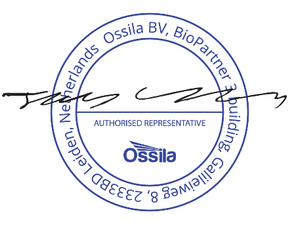
Name: Dr James Kingsley
Place: Leiden
Date: 16/11/2021
| Декларация | за съответствие на ЕС |
|---|---|
| Производител | Ossila BV, Biopartner 3 building, Galileiweg 8, 2333 BD Leiden, NL. |
| Декларира с цялата си отговорност, че посоченото оборудване съответства на приложимото законодателство на ЕС за хармонизиране, посочено на предходната(-ите) страница(-и) на настоящия документ. | |
| [Čeština] | Prohlášení o shodě EU |
|---|---|
| Výrobce | Ossila BV, Biopartner 3 building, Galileiweg 8, 2333 BD Leiden, NL. |
| Prohlašujeme na vlastní odpovědnost, že uvedené zařízeni je v souladu s příslušnými harmonizačními předpisy EU uvedenými na předchozích stranách tohoto dokumentu. | |
| [Dansk] | EU-overensstemme lseserklærin g |
|---|---|
| Producent | Ossila BV, Biopartner 3 building, Galileiweg 8, 2333 BD Leiden, NL. |
| Erklærer herved, at vi alene er ansvarlige for, at det nævnte udstyr er i overensstemmelse med den relevante EUharmoniseringslovgivning, der er anført på den/de foregående side(r) i dette dokument. | |
| [Deutsch] | EU-Konformitätserklärung |
|---|---|
| Hersteller | Ossila BV, Biopartner 3 building, Galileiweg 8, 2333 BD Leiden, NL. |
| Wir erklären in alleiniger Verantwortung, dass das aufgeführte Gerät konform mit der relevanten EUHarmonisierungsgesetzgebung auf den vorangegangenen Seiten dieses Dokuments ist. | |
| [Eesti keel] | ELi vastavusavaldus |
|---|---|
| Tootja | Ossila BV, Biopartner 3 building, Galileiweg 8, 2333 BD Leiden, NL. |
| Kinnitame oma ainuvastutusel, et loetletud seadmed on kooskõlas antud dokumendi eelmisel lehelküljel / eelmistel lehekülgedel ära toodud asjaomaste ELi ühtlustamise õigusaktidega. | |
| [Ελληνικά] | Δήλωση πιστότητας ΕΕ |
|---|---|
| Κατασκευαστής | Ossila BV, Biopartner 3 building, Galileiweg 8, 2333 BD Leiden, NL. |
| Δηλώνουμε υπεύθυνα όn ο αναφερόμενος εξοπλισμός συμμορφώνεται με τη σχεnκή νομοθεσία εναρμόνισης της ΕΕ που υπάρχει σnς προηγούμενες σελίδες του παρόντος εγγράφου. | |
| [Español] | Declaración de conformidad UE |
|---|---|
| Fabricante | Ossila BV, Biopartner 3 building, Galileiweg 8, 2333 BD Leiden, NL. |
| Declaramos bajo nuestra única responsabilidad que el siguiente producto se ajusta a la pertinente legislación de armonización de la UE enumerada en las páginas anteriores de este documento. | |
| [Français] | Déclaration de conformité UE |
|---|---|
| Fabricant | Ossila BV, Biopartner 3 building, Galileiweg 8, 2333 BD Leiden, NL. |
| Déclarons sous notre seule responsabilité que le matériel mentionné est conforme à la législation en vigueur de l'UE présentée sur la/les page(s) précédente(s) de ce document. | |
| [Hrvatski] | E.U izjava o sukladnosti |
|---|---|
| Proizvođač | Ossila BV, Biopartner 3 building, Galileiweg 8, 2333 BD Leiden, NL. |
| Izjavljujemo na vlastitu odgovornost da je navedena oprema sukladna s mjerodavnim zakonodavstvom EU-a o usklađivanju koje je navedeno na prethodnoj(nim) stranici(ama) ovoga dokumenta. | |
| [Italiano] | Dichiarazione di conformità UE |
|---|---|
| Produttore | Ossila BV, Biopartner 3 building, Galileiweg 8, 2333 BD Leiden, NL. |
| Si dichiara sotto la propria personale responsabilità che l'apparecchiatura in elenco è conforme alla normativa di armonizzazione UE rilevante indicata nelle pagine precedenti del presente documento. | |
| [Latviešu] | ES atbils tības deklarācija |
|---|---|
| Ražotājs | Ossila BV, Biopartner 3 building, Galileiweg 8, 2333 BD Leiden, NL. |
| Ar pilnu atbilclību paziņojam, ka uzskaitītais aprīkojums atbilst attiecīgajiem ES saskaņošanas tiesību aktiem, kas minēti iepriekšējās šī dokumenta lapās. | |
| [Lietuvių k.] | ES atitikties deklaracija |
|---|---|
| Gamintojas | Ossila BV, Biopartner 3 building, Galileiweg 8, 2333 BD Leiden, NL. |
| atsakingai pareiškia, kad išvardinta įranga atitinka aktualius ES harmonizavimo teisės aktus, nurodytus ankstesniuose šio dokumento | |
| [Magyar] | EU-s megfelelőségi nyilatkozat |
|---|---|
| Gyártó | Ossila BV, Biopartner 3 building, Galileiweg 8, 2333 BD Leiden, NL. |
| Kizárólagos felelösségünk mellett kijelentjük, hogy a felsorolt eszköz megfelel az ezen dokumentum előző oldalán/oldalain található EU-s összehangolt jogszabályok vonatkozó rendelkezéseinek. | |
| [Nederlands] | EU-Conformiteitsverklaring |
|---|---|
| Fabrikant | Ossila BV, Biopartner 3 building, Galileiweg 8, 2333 BD Leiden, NL. |
| Verklaart onder onze uitsluitende verantwoordelijkheid dat de vermelde apparatuur in overeenstemming is met de relevante harmonisatiewetgeving van de EU op de vorige pagina('s) van dit document. | |
| [Norsk] | EU-samsvarserklæ ring |
|---|---|
| Produsent | Ossila BV, Biopartner 3 building, Galileiweg 8, 2333 BD Leiden, NL. |
| Erklærer under vårt eneansvar at utstyret oppført er i overholdelse med relevant EU-harmoniseringslavverk som står på de(n) forrige siden(e) i dette dokumentet. | |
| [Polski] | Deklaracja zgodności Unii Europejskiej |
|---|---|
| Producent | Ossila BV, Biopartner 3 building, Galileiweg 8, 2333 BD Leiden, NL. |
| Oświadczamy na własną odpowiedzialność, że podane urządzenie jest zgodne ze stosownymi przepisami harmonizacyjnymi Unii Europejskiej, które przedstawiono na poprzednich stronach niniejszego dokumentu. | |
| [Por tuguês] | Declaração de Conformidade UE |
|---|---|
| Fabricante | Ossila BV, Biopartner 3 building, Galileiweg 8, 2333 BD Leiden, NL. |
| Declara sob sua exclusiva responsabilidade que o equipamento indicado está em conformidade com a legislação de harmonização relevante da UE mencionada na(s) página(s) anterior(es) deste documento. | |
| [Română] | Declaraţie de conformitate UE |
|---|---|
| Producător | Ossila BV, Biopartner 3 building, Galileiweg 8, 2333 BD Leiden, NL. |
| Declară pe proprie răspundere că echipamentul prezentat este în conformitate cu prevederile legislaţiei UE de armonizare aplicabile prezentate la pagina/paginile anterioare a/ale acestui document. | |
| [Slovensky] | Vyhlásenie o zhode pre EÚ |
|---|---|
| Výrobca | Ossila BV, Biopartner 3 building, Galileiweg 8, 2333 BD Leiden, NL. |
| Na vlastnú zodpovednosť prehlasuje, že uvedené zariadenie je v súlade s príslušnými právnymi predpismi EÚ o harmonizácii uvedenými na predchádzajúcich stranách tohto dokumentu. | |
| [Slovenščina] | Izjava EU o skladnosti |
|---|---|
| Proizvajalec | Ossila BV, Biopartner 3 building, Galileiweg 8, 2333 BD Leiden, NL. |
| s polno odgovornostjo izjavlja, da je navedena oprema skladna z veljavno uskladitveno zakonodajo EU, navedeno na prejšnji strani/prejšnjih straneh tega dokumenta. | |
| [Suomi] | EU-vaatimustenm ukaisuusvakuutus |
|---|---|
| Valmistaja | Ossila BV, Biopartner 3 building, Galileiweg 8, 2333 BD Leiden, NL. |
| Vakuutamme täten olevamme yksin vastuussa siitä, että tässä asiakirjassa luetellut laitteet ovat tämän asiakirjan sivuilla edellisillä sivuilla kuvattujen olennaisten yhdenmukaistamista koskevien EU-säädösten vaatimusten mukaisia. | |
| [Svenska] | EU-försäkran om överensstämmelse |
|---|---|
| Tillverkare | Ossila BV, Biopartner 3 building, Galileiweg 8, 2333 BD Leiden, NL. |
| Vi intygar härmed att den utrustning som förtecknas överensstämmer med relevanta förordningar gällande EUharmonisering som fmns på föregående | |
3. Safety
3.1 Warning
- Only use the 24V power adapter and power cord supplied with the unit.
- If using flammable or hazardous solvents, users are expected to be trained in their usage and carry out a COSHH risk assessment.
- Keep the area around the machine clear, approximately a 150 cm clearance above and 150 cm to the sides and behind.
- Keep clear of the machine while it is in operation.
- If using hazardous solvents always use within a fume hood or controlled environment.
- There are pinch points when in operation, keep hands clear of moving parts.
- Do not use in an explosive atmosphere.
3.2 Use of Equipment
This Dip Coater is designed to be used as instructed and under the following conditions:
- Indoors in a laboratory environment (pollution degree 2).
- Altitudes up to 2000 m.
- Temperatures of 5°C to 40°C; maximum relative humidity of 80% up to 31°C.
The Dip Coater is supplied with a 24 VDC power adapter with a power cord for the country of purchase, (in accordance with European Commission regulations and British Standards). The use of any other electrical power cables, adaptors, or transformers is not recommended.
3.3 Hazard Icons
The following symbols that can be found at points throughout the rest of the manual.
Table 3.1 Hazard warning labels used in this manual.
| Symbol | Associated Hazard |
|---|---|
 |
General warning or caution, which accompanying text will explain |
 |
Electrical shock |
 |
Pinch point |
3.4 General Hazards
Before installing or operating the Dip Coater, there are several health and safety precautions which must be followed and executed to ensure safe installation and operation.

CAUTION: During operation, the movement of the clamping arm could result in a pinch point hazard. Caution should be taken whenever the system is in operation.

Emergency power disconnect options: Use the power cord as a disconnecting method and remove it from the power source. To facilitate disconnect, make sure the power outlet for this cord is readily accessible to the operator.
3.5 Servicing
If servicing is required, please return the unit to Ossila Ltd. The warranty will be invalidated if:
- Modification or service has taken place by anyone other than an Ossila engineer.
- The Unit has been subjected to chemical damage through improper use.
- The Unit has been rendered inoperable through accident, misuse, contamination, improper maintenance, modification, or other external causes.
3.6 Health and Safety - Installation

Pinch points are present during operation of the Dip Coater. As a precaution, users should avoid handling or leaning over the equipment during operation in order to avoid possible crushing or entanglement of hair and/or clothing.
3.7 Health and Safety - Servicing

Servicing should only be performed by an Ossila engineer. Any modification or alteration may damage the equipment, cause injury, or death. It will also void your equipment’s warranty.
3.8 Crash Detection Switch
The Dip Coater is fitted with an inbuilt crash-detection switch. The crash-detection switch is housed within the connection between the mounting arm and stage (see Figure 3.1). During normal operation, the safety switch will remain in a constant ‘ON’ state, with the bar attached to the motor pressing against the switch. When the arm encounters an object (e.g. a hand, beaker, or the base of the equipment), it will cause the arm and the housing of the switch to rotate relative to the bar attached to the motor. This releases the switch, setting it to an ‘OFF’ state and cutting power to the motor.
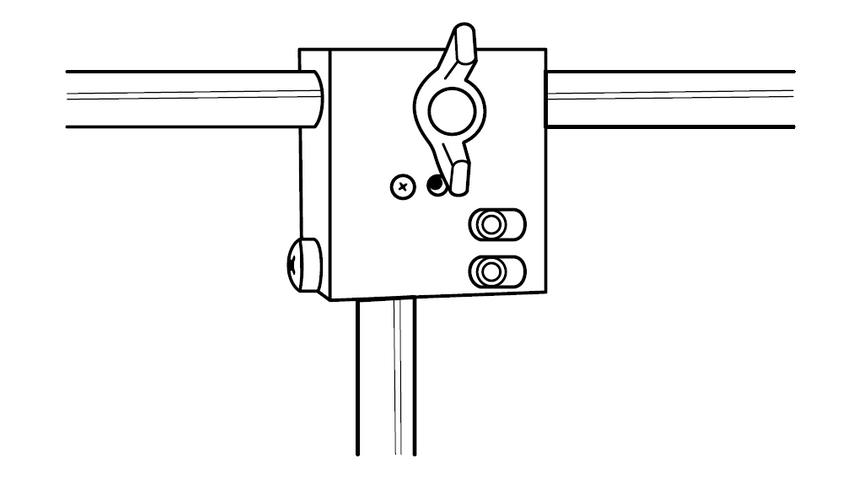
4. Unpacking
4.1 Packing List
The standard items included with the Dip Coater are:
- The Dip Coater unit
- Dipping arm and clamp
- Power adapter with a power cord (specific for country of operation)
4.2 Damage Inspection
Examine the components for any evidence of shipping damage. If damage has occurred, please contact Ossila directly for further action. The shipping box comes with a shock indicator to show if there has been mishandling of the package during transportation.
5. Specifications
The Dip Coater specifications are shown in Table 5.1 and Table 5.2
Table 5.1 Dip Coater specifications
| Travel Length | 100 mm |
|---|---|
| Minimum Speed | 0.01 mm.s-1; 0.6mm.min-1 |
| Maximum Speed | 50 mm.s-1; 3000 mm.min-1 |
| Positional Reproducibility | 0.01% |
| Rate Reproducibility | 0.1% |
| Maximum Substrate Length | 100 mm |
| Maximum Number of Cycles | 1000 cycles |
| Maximum Timer Duration | 99:59:59 (HH:MM:SS) |
| Power Supply | Input: 100-230V; 50/60Hz; 50VA Output: 24 VDC / 2A power adapter (supplied with the unit) |
| Dimensions |
Width: 300 mm Height: 200 mm Depth: 350 mm (450 mm at full extension) |
| Operating Temperature/Humidity | 5°C to 40°C; Up to 80% RH at 31°C |
| Weight | <5 kg |
Table 5.2 Dip Coater software specifications
| Units | mm.s-1, mm.min-1 |
|---|---|
| Users | Total of 10 user profiles to select from |
| Settings Mode | Set solution height; substrate length; substrate position; units |
| Manual Mode | Set immersion speed; withdrawal speed; control motion using keypad |
| Programmes | Each user has 10 individual programmes that can be saved |
| Programme Mode | Set immersion rate; dwell time; initial withdrawal rate; final withdrawal rate; dry time; number of cycles |
6. System Components
The Dip Coater comes with the following components:
- Dip Coater unit (Figure 6.1)
- Power supply cord and power supply (Figure 6.2)
- Dipping arm and clamp
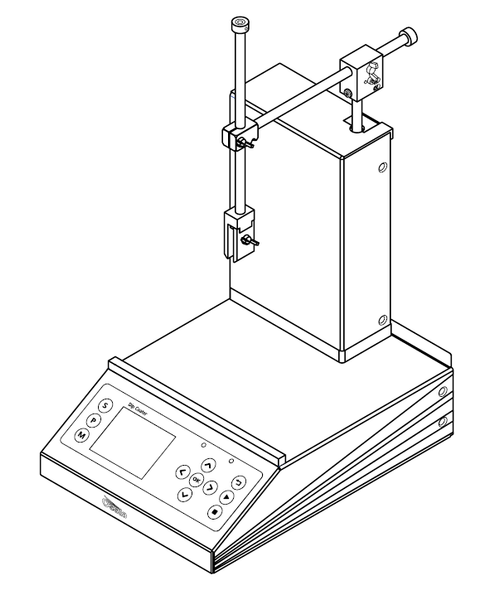
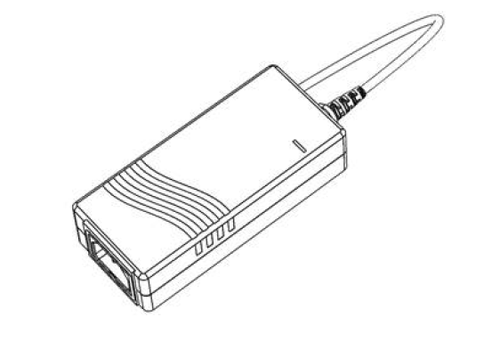
7. Installation
- Place the unit on a solid, level surface.
Ensure the area is free from vibrations, temperature extremes, and highly flammable or explosive materials. Keep the area surrounding the machine clear, with approximately 150 mm clearance above the machine, to the sides of the machine, and behind the machine.
- Before plugging in the Dip Coater, ensure the power switch on the unit is switched to the ‘0’ position (off).
- Connect the power supply connector to the Dip Coater. See Figure 7.1 for connecting the power supply cable to the Dip Coater.
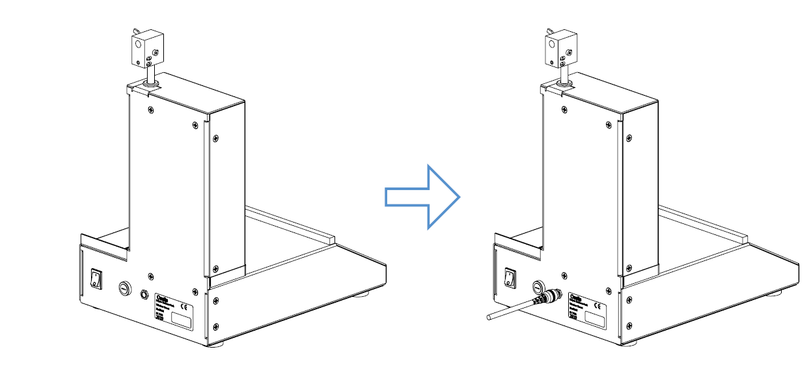
- Switch the Dip Coater power switch to the ‘1’ position to turn on.
- To install the dipping arm loosen the wingnut on the side of the black metal block that houses the crash detection switch.
- Slide the dipping arm into the hole in the black metal block (See Figure 7.2). The dipping position of the arm can be adjusted by varying how far this is inserted.

- When the dipping arm is in the desired position (ideally in the middle of the platform) tighten the wingnut screw until the arm no longer slides.
8. Operation
8.1 Dip Coater Diagram
An isometric view of the glove box is shown in Figure 8.1, with all the relevant components highlighted.
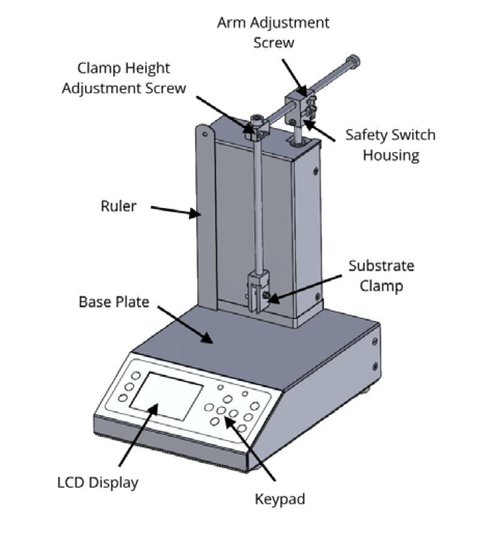
8.2 Dip Coater User Interface
Figure 8.2 shows the front panel of the Dip Coater, where the function of each of the keypad buttons is explained in Table 8.1
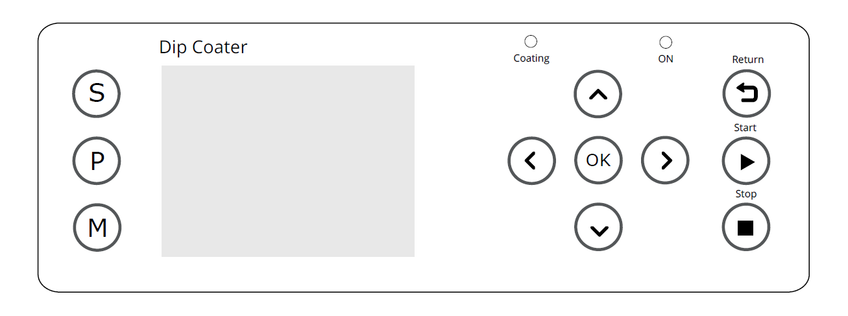
Table 8.1 Operational buttons and their associated functions
| Button | Function |
|---|---|
| S (Settings) | Opens the Settings menu where the solution height, substrate length, and substrate position can be set. The units can also be altered here. |
| M (Manual) | Enters the Manual mode where the immersion speed and withdrawal speed can be set. The arm can be immersed and withdrawn manually. |
| P (Program) | Enters the Programming mode where saved programs can be selected and/or edited. |
 |
Navigates ‘up’ through the menu; increases selected values by 1; cycles through options; moves the arm upwards (manual mode only). |
 |
Navigates ‘down’ through menus; decreasing selected values by 1; cycling through options; moving the arm downwards (manual mode only). |
 |
Navigates ‘right’ through menus |
 |
Navigates ‘left’ through menus |
 |
Press to select, edit, or accept changes |
 |
Stop the currently running program. |
 |
Start the program. |
8.3 Practical Operation

WARNING: Volatile solvents
When using volatile solvents or hazardous solvents/materials, the instrument should be placed within a fume hood or glove box. When using the Dip Coater, a general start-up procedure should be followed before beginning to coat.
8.3.1 Positioning the Dipping Arm
- Turn the unit on, press the ‘M’ button to enter the manual mode. Adjust the arm to its lowest position.
- Using the clamp height adjustment screw, raise the clamping arm so that it is around 10 mm higher than the maximum length of the substrate you are coating.
- Press return to raise the arm to the top.
8.3.2 Positioning the Reservoir and Dipping Arm
- Place the solution reservoir on the base plate of the unit.
- Center the reservoir under the dipping arm.
- The position of the dipping arm can be adjusted to be nearer or further away from the user by loosening the arm adjustment screw.
- Ensure that there is a distance of at least 1 cm from the edge of the baseplate of the Dip Coater.
8.3.3 Adjusting Clamp Strength
- Pull back one half of the clamp and insert a substrate, being sure to provide support in case the clamp strength is not yet high enough.
- Let go of the substrate to check if the clamp can currently support its weight.
- If the substrate begins to slip, tighten the clamp adjustment screw to increase the pressure from the spring.
- The screw should be tightened until the substrate is held securely in place.
- If a delicate substrate is being used, you can reduce the clamp pressure by loosening the adjustment screw.
8.3.4 Setting the Solution Height, Substrate Position and Coating Length
In the ‘settings’ mode, you can:
- Update the length that you wish to coat over.
- The height of the solution relative to the ruler provided.
- The position of the bottom of the mounted substrate relative to the ruler provided.
8.4 Program Operation
8.4.1 Dip Coater Start Up
|
 |
|
 |
|
 |
|
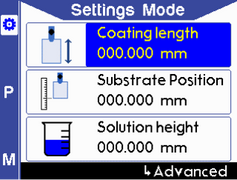 |
8.4.2 Settings Mode
|
|
|
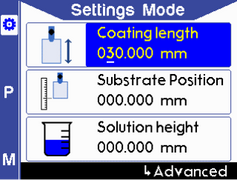 |
|
The maximum travel distance of the system is 100 mm. Any coating length and drying gap values (refer to Step 7) should be within maximum travel distance. The coating length will be auto corrected if the added value is more than 100mm, and you will be alerted by a warning message. |
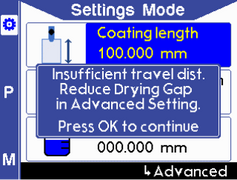 |
|
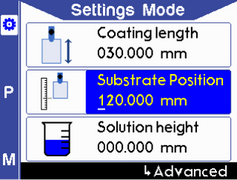 |
|
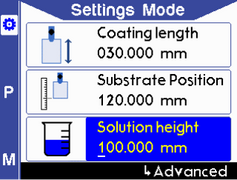 |
|
A warning message will appear if the difference between substrate position and solution height plus coating length and drying gap is more than the maximum travel distance (100 mm). |
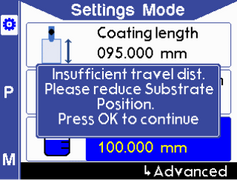 |
|
A warning will appear if the substrate position is set below the solution height. |
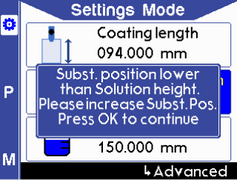 |
|
 
|
|
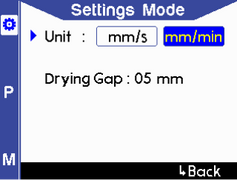 |
The maximum drying gap is 50 mm, and the default value is 5 mm. |
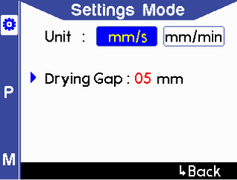 |
|
The maximum travel distance of the system is 100 mm. Any increases in coating length value (in Step 2) and Drying Gap should be within this maximum travel distance. The coating length will be autocorrected if the added value is more than 100 mm. |
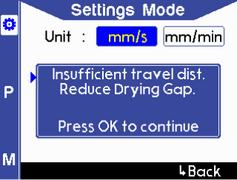 |
|
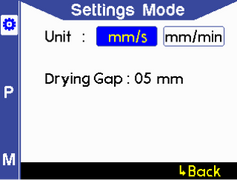 |
8.4.3 Manual Mode
|
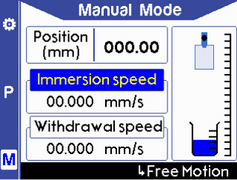 |
|
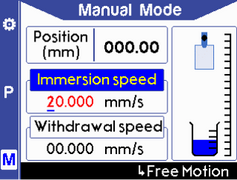 |
|
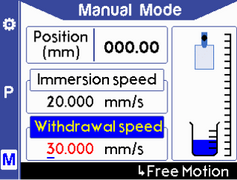 |
The maximum travel distance is 100 mm. |
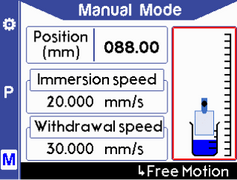 |
|
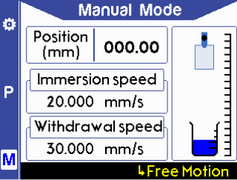 |
|
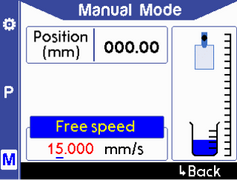 |
|
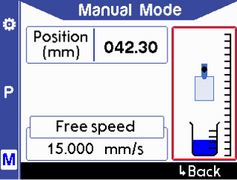 |
|
 
|
8.4.4 Program Mode
|
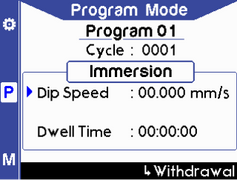 |
The maximum number of programs is 20. |
 
|
The maximum number of cycles is 1000. |
 
|
The maximum Dip Speed is 50 mm/s or 3000 mm/min.
|
 
|
The Dwell Time format is: HH:MM:SS (H = Hour, M = Minute, S = Second). |
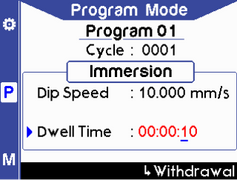 |
|
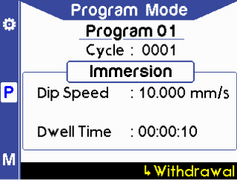 |
The maximum initial withdrawal speed is 50 mm/s or 3000 mm/min
|
 
|
The maximum Final Withdrawal Speed is 50 mm/s or 3000 mm/min.
|
 
|
The dry time format is: HH:MM:SS; (H = Hour, M = Minute, S = Second). |
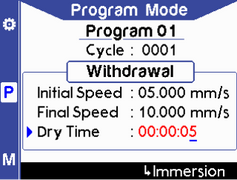 |
|
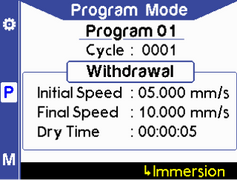 |
|
 
|
|
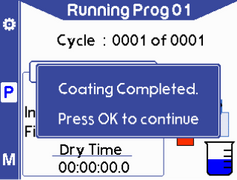 |
A warning will appear if any of the conditions below occur:
|
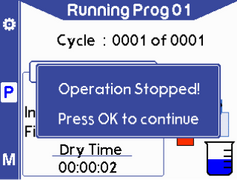 |
|
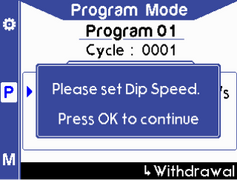 |
|
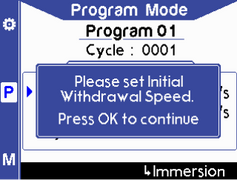 |
|
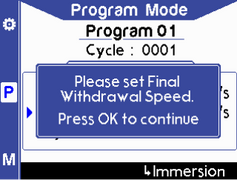 |
|
 
|
|
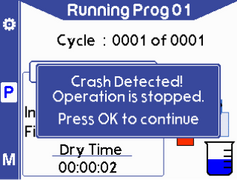 |
8.5 Operational Safety
Any procedure that is done with the Dip Coater should be carried out with a suitable operating procedure, risk assessment, and COSHH forms to ensure that the user knows and understands the potential hazards inherent to the system of work they are undertaking. The following are safety points that should be noted by the user before any procedure is undertaken with the Dip Coater.
8.5.1 Pinch Points
The dip coating arm presents the risk of a pinch point to the user. We recommend that users do not place their hands near the moving parts while a programme is running or during the manual movement of the Dip Coater.
8.5.2 Sources of Ignition
Solvents can often be highly volatile, with some having flash and flame points below that of room temperature. To minimize the risk of fire with solutions in use, users should ensure that no sources of ignition are placed close to the dip coating system. In the case of using any hazardous solvents the system should be housed in a fume hood where solvent vapor cannot accumulate.
9. Maintenance
9.1 Cleaning
Maintenance consists of periodic cleaning. The exterior of the instrument can be cleaned with a clean, dry cloth to remove any oil, grease, or grime. Never use liquid solvents or detergents. Repairs or servicing not covered in this manual should only be performed by qualified personnel.
10. Troubleshooting
| Problem | Possible Cause | Action |
|---|---|---|
| No power/display | The power switch on the unit is in the OFF position | Check the connection ande ensure power is turned ON |
| The power supply may not be connected properly | Ensure the unit is firmly plugged in to the power supply, and the plug is firmly connected to both the adapter and the working power socket | |
| The fuse on the rear panel has blown | Ensure the unit is unplugged. Check the fuse on the rear panel. If it has blown, replace with a suitably rated 1A slow blow fuse | |
| The power supply adapter has a fault | Contact Ossila for a replacement power supply adapter | |
| No obvious cause | If all the above causes have been considered, there may be a fault on the board. Please contact Ossila for information | |
| Crash warning | The safety switch in the crash switch housing has not been returned to its ON state | Ensure that the arm position is returned to its initial position and that no obstruction to the arms movement remains |
| The safety switch in the crash switch housing has developed a fault | If the above has not resolved the issue, please contact Ossila for more information | |
| System error | The secondary safety switch has accidentally been triggered | Turn the unit off and on again to see if the warning remains |
| Internal fault in the secondary safety switch | If all the above has been considered there may be a fault with the secondary safety switch. Contact Ossila for more information |
Dip Coater
